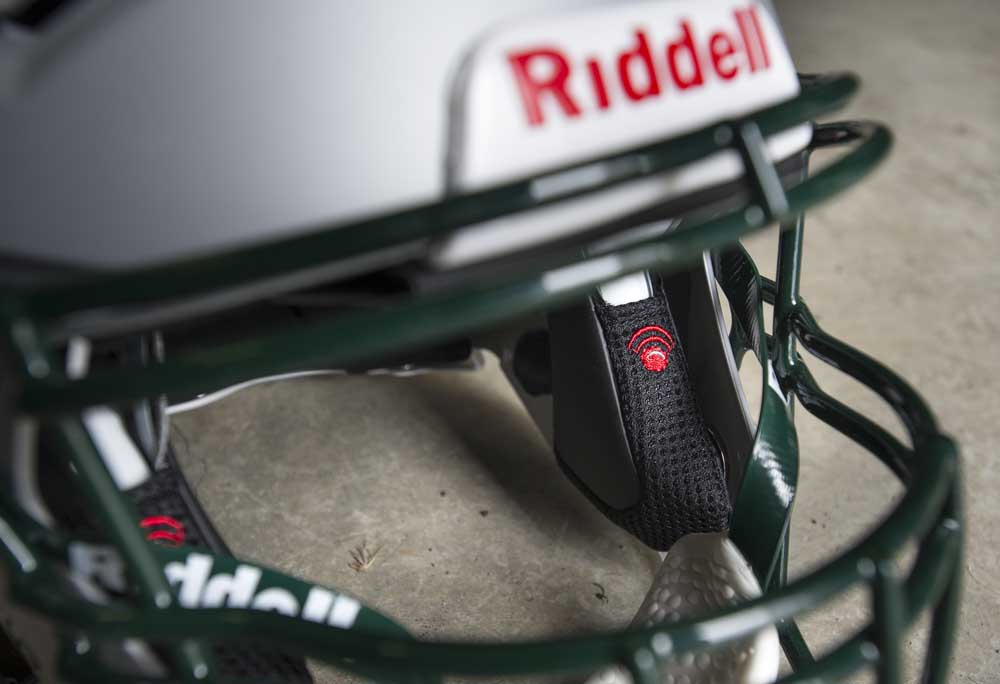Helmets give Summit coaches valuable information about concussions
Published 12:00 am Tuesday, November 13, 2018

- A small red logo is one of the only ways to tell the difference between a standard football helmet and a Riddell impact-monitoring one. The helmets have onboard electronics that evaluate each impact that occurs during a game or practice and sends an alert to a monitor when impact thresholds are exceeded.(Ryan Brennecke/Bulletin file photo)
Summit endured a challenging season on the football field this year, finishing 2-7 overall in its first season since being elevated to Class 6A. Storm coach Corben Hyatt says his relatively young team learned a lot along the way, as did the coaches.
But perhaps the more crucial lessons learned by Summit coaches and players were less about performance and more about safety.
The Storm players this season were outfitted with special helmets — Riddell SpeedFlex with InSite Training Tool — that monitored the severity of hits and potential concussion risk. A five-zone sensor pad embedded inside the helmets collected data from each practice and game. Coaches could then view that data on an online platform and also analyze impact monitors, the size of a small cellphone, that alerted them in real time of any potentially dangerous collisions.
By providing such information, the helmets are meant to help eventually combat declining participation in tackle football due to concern over concussions and long-term brain injuries suffered from hits on the field.
The benefits of the helmets were twofold: 1) Hyatt, assistant coaches and team trainer Shauna Ericksen could evaluate a player whose helmet signaled an alert, and 2) Hyatt and his staff could monitor the data to adjust how they coached certain tackling or blocking techniques or modify practice drills.
Hyatt says that for about 80 percent of his players, the data registered nothing unusual. But for the other 20 percent he found some abnormalities.
“Some guys were leading with their head more, where the blows were bigger impacts,” Hyatt says. “Some guys take the majority of their hits to a certain side of the head. That means they’re turning their head on impact, so we were able to go back and teach those players different techniques. I thought from that standpoint, it was super beneficial because … we’ve got 60-plus kids out on the field for varsity and JV, and you just don’t have enough eyes to see every hit and every kid.”
Hyatt says he was concerned that the data would show an excessive number of hard, severe hits, but most of the hits recorded were measured as low impact. Still, Hyatt understands that a high number of low-impact head collisions can cause concussions and long-term problems.
“What was kind of surprising was how low impact so many of the hits are considered,” Hyatt says. “But … are these effects (concussions) happening more because of the one big hit or is it the multitude of many hits? I would look at my offensive line and see how many hits they were taking. And then I could adjust drills to make sure that we didn’t have as many of those lower impacts. There’s ways to do that. It’s teaching kids different techniques and getting their head out of it.”
Summit invested about $20,000 into the program to purchase 60 helmets, enough for its varsity and JV teams.
The funds, Hyatt says, came from the school’s football budget, leftover resources from the athletic department from the 2017-18 school year, and various fundraising efforts.
The number of youngsters participating in the Bend Park & Recreation District tackle football program decreased by more than one-third from 2012 to 2017, according to earlier reporting by The Bulletin. The decline is likely triggered by rising concerns over head injuries. The number of diagnosed concussions among football players in the United States doubled between 2005 and 2015, according to recent research by Northwestern University.
Summit joined Centennial of Gresham, Hood River Valley, Lincoln of Portland and Valley Catholic of Beaverton as the only high school football programs in Oregon that used InSite this season.
According to Riddell, the Illinois-based sports equipment company behind InSite, more than 30,000 players in more than 1,000 programs across the country, including 100 collegiate programs, have been implementing the InSite technology, which was made available to the public starting in 2014.
“These things aren’t going to stop concussions,” Hyatt says of the helmets. “What it was going to more do for us was give us an idea of what is actually going on during our practices and games, and give us insight on where blows are happening, the frequency of them, the levels of them. I thought that was kind of interesting. Overall I would say it’s a good investment for us. I mean, it’s a lot of work. You’ve got to put in the time on it, but in this day and age, if there’s technology out there, we’ve got to figure out how to utilize it to help protect players.”
As is common with new technology, the helmets were not without their glitches. Ericksen, the Summit trainer, says that the helmets’ sensors would sometimes signal an alert when, for example, a player dropped his helmet on a locker room bench. And the threshold for what constitutes a potentially dangerous hit is somewhat unclear, she notes.
But when working correctly, the InSite program offered a useful measurement device for Ericksen to check on players involved in a hard hit.
“I would go up to the athlete and ask them how they were doing,” Ericksen says. “They would remember the hit, and usually not show any symptoms or signs that he got a concussion. It kept the communication line open, which really helps.”
Ericksen says Summit players suffered several concussions this past season but not many severe ones. And most of the time, she saw the play that resulted in the concussion.
“The (helmet) alert would go off when I already knew I would do an evaluation on (the involved player),” Ericksen says. “But with it being such an intense environment and there’s so many things going on and distractions, having that alert just kind of focuses me on one player where I could be assessing something else and not be able to see the play.”
Hyatt says he plans to continue the InSite program next season for his varsity and JV players. He hopes that the information provided by the helmets can help pave the way to improving participation numbers in youth tackle football and on into high school.
“You always want to protect your athletes and have a better understanding of what’s going on with them,” Hyatt says. “But also be able to answer those questions from parents at the high school, middle school and youth levels who are so concerned — which we all are — about the information that’s out there now with concussions. This is just another way for me to have those conversations with parents and say, look, we can’t eliminate all these (concussions), but here’s what we’re doing to be more aware of them, and try to ease those concerns of having their kids play tackle football.”
— Reporter: 541-383-0318,
mmorical@bendbulletin.com








